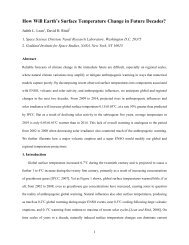University of California - Leif and Vera Svalgaard's
University of California - Leif and Vera Svalgaard's
University of California - Leif and Vera Svalgaard's
- No tags were found...
You also want an ePaper? Increase the reach of your titles
YUMPU automatically turns print PDFs into web optimized ePapers that Google loves.
362 C.O. Lee et al.SC 23 period, there would be deeper rarefaction regions <strong>and</strong> thus lower magnetic fields inthose regions.Based on the Ulysses observations reported by Smith <strong>and</strong> Balogh (2009), the weakerecliptic fields may also be due to less open solar flux. However, since the ecliptic observations<strong>and</strong> model results shown in this study indicate that the low- to mid-latitude fluxis not only from the polar regions (also see Luhmann et al., 2009, for a discussion) <strong>and</strong> ismoreover latitudinally redistributed by stream interactions, the interpretation is complicated.Future modeling <strong>of</strong> both the Ulysses <strong>and</strong> ecliptic IMF data together (P. Riley, private communication,2008) may shed more light on the origins <strong>of</strong> the weaker ecliptic IMF <strong>of</strong> thissolar cycle period. In the meantime, caution must be exercised in evaluating these weakerecliptic fields.Acknowledgements The authors would like to thank Todd Hoeksema <strong>and</strong> Xu Dong Sun for their usefulsuggestions, the NASA Goddard Space Flight Center Space Physics Data Facility (SPDF) for providing theOMNI data access, the NASA/CCMC for their dedicated assistance in making the model computer runsneeded for this study, <strong>and</strong> the National Solar Observatory <strong>and</strong> Wilcox Solar Observatory for providing accessto their magnetogram data sets. This research was supported by the 2005 – 2006 National Defense Science<strong>and</strong> Engineering Graduate (NDSEG) Fellowship awarded by the Department <strong>of</strong> Defense (DoD) <strong>and</strong> the CISMproject, which is funded by the STC Program <strong>of</strong> the National Science Foundation under agreement numberATM-0120950.Open Access This article is distributed under the terms <strong>of</strong> the Creative Commons Attribution NoncommercialLicense which permits any noncommercial use, distribution, <strong>and</strong> reproduction in any medium, providedthe original author(s) <strong>and</strong> source are credited.ReferencesAcuña, M.H., Curtis, D., Scheifele, J.L., Russell, C.T., Schroeder, P., Szabo, A., Luhmann, J.G.: 2008, TheSTEREO/IMPACT magnetic field experiment. Space Sci. Rev. 136, 203 – 226.Arge, C.N., Pizzo, V.J.: 2000, Improvement in the prediction <strong>of</strong> solar wind conditions using near-real timesolar magnetic field updates. J. Geophys. Res. 105, 10465 – 10479.Arge, C.N., Luhmann, J.G., Odstrcil, D., Schrijver, C.J., Li, Y.: 2004, Stream structure <strong>and</strong> coronal sources<strong>of</strong> the solar wind during the May 12th, 1997 CME. J. Atmos. Solar Terr. Phys. 66, 1295 – 1309.Balogh, A., Beek, T.J., Forsyth, R.J., Hedgecock, P.C., Marquedant, R.J., Smith, E.J., Southwood, D.J., Tsurutani,B.T.: 1992, The magnetic field investigation on the Ulysses mission: Instrumentation <strong>and</strong> preliminaryscientific results. Astron. Astrophys. Suppl. Ser. 92, 221 – 236.Bame, S.J., McComas, D.J., Barraclough, B.L., Phillips, J.L., S<strong>of</strong>aly, K.J., Chavez, J.C., Goldstein, B.E.,Sakurai, R.K.: 1992, The Ulysses solar wind plasma experiment. Astron. Astrophys. Suppl. Ser. 92,237 – 265.Delaboudiniere, J.P., Artzner, G.E., Brunaud, J., Gabriel, A.H., Hochedez, J.F., Millier, F., Song, X.Y., Au,B., Dere, K.P., Howard, R.A., et al.: 1995, EIT: Extreme-ultraviolet imaging telescope for the SOHOmission. Solar Phys. 162, 291 – 312.Henney, C.J., Keller, C.U., Harvey, J.W.: 2006, SOLIS-VSM solar vector magnetograms. In: Casini, R., Lites,B.W. (eds.) Solar Polarization 4 CS-358, Astron. Soc. Pac., San Francisco, 92 – 95.Hiltula, T., Mursula, K.: 2006, Long dance <strong>of</strong> the bashful ballerina. Geophys. Res. Lett. 33, L03105.doi:10.1029/2005GL025198.Howard, R.A., Moses, J.D., Socker, D.G., Dere, K.P., Cook, J.W.: 2002, Sun Earth Connection Coronal <strong>and</strong>Heliospheric Investigation (SECCHI). Adv. Space Res. 29, 2017 – 2026.Issautier, K., Le Chat, G., Meyer-Vernet, N., Moncuquet, M., Hoang, S., MacDowell, R.J., McComas,D.J.: 2008, Electron properties <strong>of</strong> high-speed solar wind from polar coronal holes obtained byUlysses thermal noise spectroscopy: Not so dense, not so hot. Geophys. Res. Lett. 35, L19101.doi:10.1029/2008GL034912.Jian, L., Russell, C.T., Luhmann, J.G., Skoug, R.M.: 2006, Properties <strong>of</strong> interplanetary coronal mass ejectionsat one AU during 1995 – 2004. Solar Phys. 239, 393 – 436.Kaiser, M.: 2005, The STEREO mission: an overview. Adv. Space Res. 36, 1483 – 1488.




![When the Heliospheric Current Sheet [Figure 1] - Leif and Vera ...](https://img.yumpu.com/51383897/1/190x245/when-the-heliospheric-current-sheet-figure-1-leif-and-vera-.jpg?quality=85)

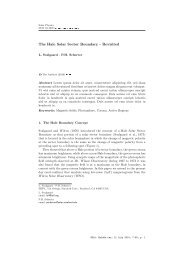

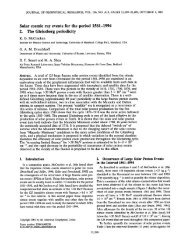
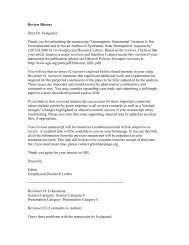

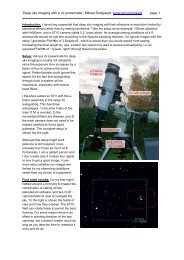
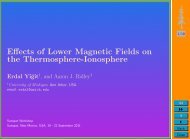
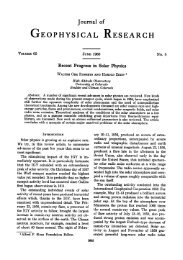
![The sum of two COSine waves is equal to [twice] the product of two ...](https://img.yumpu.com/32653111/1/190x245/the-sum-of-two-cosine-waves-is-equal-to-twice-the-product-of-two-.jpg?quality=85)
